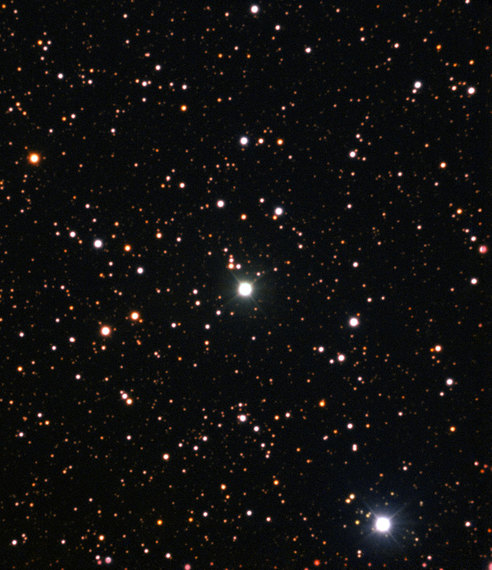When I had finally given up the hope, this year astronomers have reached twice a goal which I have dreamed to see for about 25 years. They caught in the act lithium formation in stars for the first time, observing it in the spectra of the matter ejected in two different novae, exploded in 2013.

V1369 Cen (Nova Centauri 2013) from the NTT ESO telescope, image taken in July 2015, one year and half after the explosion. It is the brightest star in the centre of the picture. Credit: ESO
Lithium is formed during the primordial Big Bang Nucleosynthesis (BBN). When the fireball begins expanding, its temperature progressively lowers, reaching thresholds which modify its main components. The timing for building up deuterium (D), tritium (H), the isotopes 3 and 4 of helium (He and He) and the main lithium isotope (Li) is confined between about 2 minutes and 15 minutes of age of the newborn Universe, when the temperature passes through the range from a billion to about 300 million degrees.
Notice that all the other elements are synthesized much later, most of them by nuclear reactions in the interior of stars, while those heavier than iron are formed in some stars by two other processes, "rapid" and/or "slow" neutron capture onto iron seed nuclei.
The most abundant final outcome of BBN is the very stable nucleus of helium, one He every 10 protons (hydrogen nuclei). An appealing result of BBN is that this abundance of helium can be derived from a back of the envelope computation, and depends on the basic proton and neutron properties, not on the details of the model. On the contrary, the precise abundances of D, He and Li depend on the barion density with which our Universe was born (one of those interesting numbers from which our own existence depends). In the beginning, the fireball contained mainly photons (energetic gamma rays), positrons, electrons, neutrinos, antineutrinos and traces of protons and neutrons (barions). The initial number ratio of barions to photons is today almost perfectly measured by the study of the Cosmic Microwave Background properties, and is about 5x10, five barions for 10 billion photons! This tiny quantity plays a role in the BBN, and, in particular, determines how much D is not processed into helium (the larger is the barion density, the smaller is the fraction of remnant D nuclei). D abundance measured in quasars are in agreement with the BBN.
The Lithium abundance emerging from the BBN is then well modeled, but the result is a problem, for two different reasons: it is about 3 times larger than the abundance we measure at the surface of the oldest stars of the Galaxy, and 4 times smaller than the abundance we measure in the stars forming today in the young stellar associations. Discussion of the first discrepancy leads us away from the main problem, so I leave it out.
The difference between the BBN value and today's Lithium abundance clearly forces us to look for lithium factories, operating mostly in the latest billion years of Universe life.
This is a difficult job, because the reaction which produces Be, by combining the two helium isotopes, during the BBN, occurs in the stellar interiors too, but when the unstable Be decays into Li, this fragile nucleus is immediately burnt. In fact, the initial lithium in the gas forming the star is the second element to be destroyed in very young stars, after D, and well before the start of the stable hydrogen burning phase, the "main sequence".
Astrophysicists have devised a model to save lithium: as Be has an half-life of about 53 days, Lithium may survive if Be quickly moves away from the hot burning regions, either by convective motions of the gas or by explosion of the region in which it formed. This latter possibility occurs in novae, where the ignition of hydrogen rich matter transferred from a binary companion on the surface of a white dwarf is "explosive" (white dwarf are so dense that only very small amounts of hydrogen rich matter may accumulate on top of their external layers, before burning explosively).
Akito Tajitsu, of the National Astronomical Observatory of Japan, and his colleagues have examined the near ultraviolet spectra of the ejecta of the fast nova V339 Del (Nova Delphini 2013), and, early this year, they have convincingly shown the presence of Be, the element from which lithium will necessarily be formed by radioactive decay. A few days ago, Izzo and colleagues announced that they have directly seen the main lithium line in the ejecta of another nova, V1369 Centauri. This latter nova is also very interesting because, at maximum brightness, it could be seen by naked eye, just as our ancestors could see these objects appear suddenly, from one night to the other, and gave them the name stella nova, new star, which they have also now.
Are these observations able to justify the Lithium abundance observed in the atmospheres of young stars? My colleague Francesca Matteucci (coauthor in the paper on V1369 nova) and I had studied the chemical evolution of Lithium 25 years ago, taking into account the possible galactic sources of Lithium, and showing for the first time the possible important role of novae, by developing a fully theoretical model for their Lithium production. Following the new observation, Izzo et al. use now a semiempirical model based on the abundance of Lithium determined in the ejecta of V1369Cen and on the frequency of galactic nova events. The number of free parameters in the model are scarcely constrained by this unique case. Another coauthor, Luca Pasquini, tells me that V1369 Cen is a "slow" nova, so its gas shell is about ten times more massive than in "fast" novae, such as the Nova Del 2013, so slow novae could indeed be relevant. These results require to explore more and more detailed nova explosion models, to finally assess the role of novae as lithium factories. We have seen some light, but the problem of Lithium is still with us.
The references are here for the paper by Tajitsu et al. 2015 published in Nature, and here for the paper by Izzo et al. 2015 published in The astrophysical Journal Letters. See also the ESO science release.
